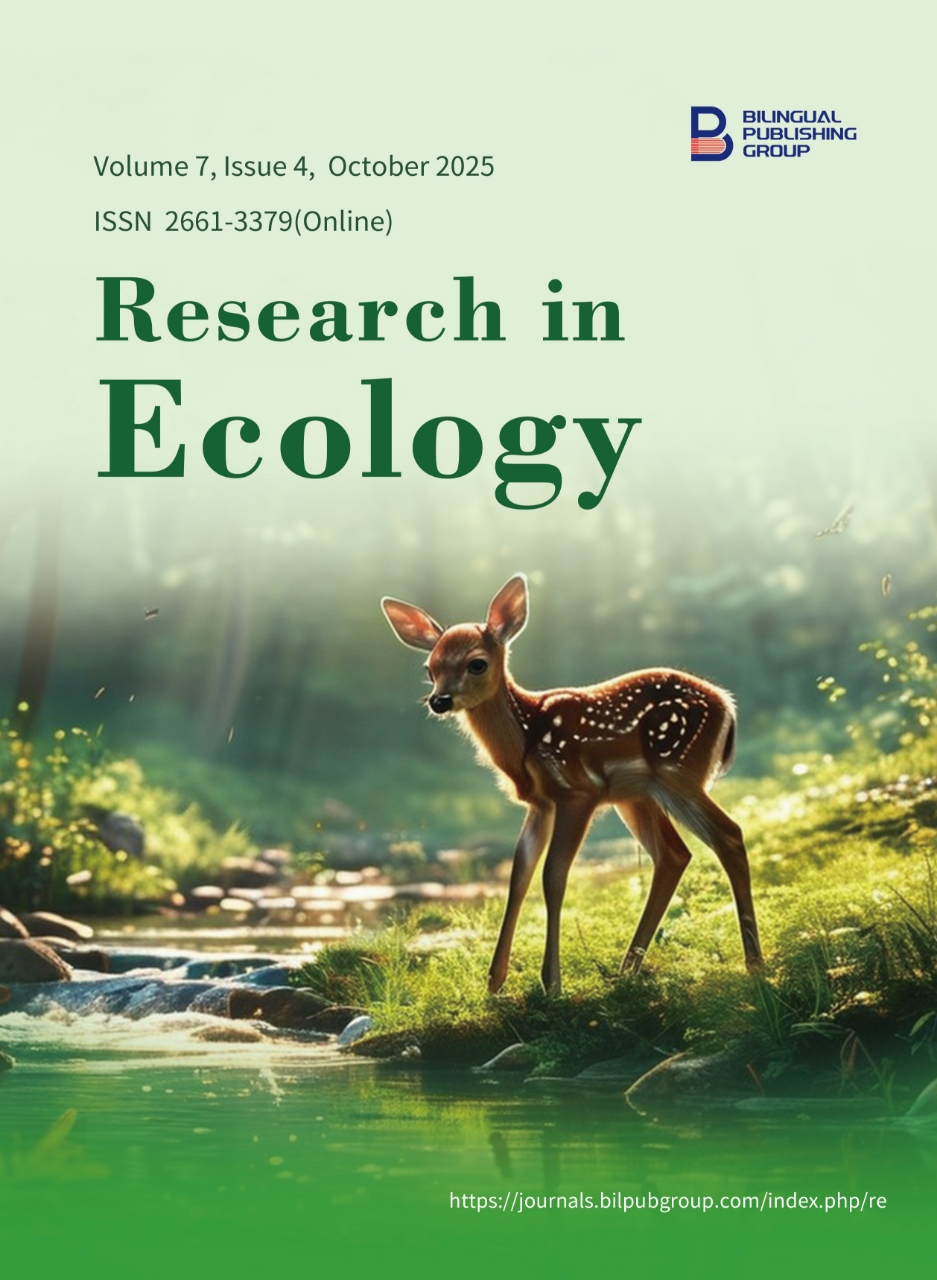
Impact of Light Crude Oil Contamination on Seed Germination and Seedling Growth in Zea Mays L
DOI:
https://doi.org/10.30564/re.v7i4.9506Abstract
This study explores the dose-dependent impacts of light crude oil contamination on seed germination and seedling growth in Zea mays L. (maize), a critical agricultural species. We hypothesized that higher concentrations of light crude oil in soil would progressively suppress germination kinetics and seedling vigor. To test this, Zea mays seeds were exposed to light crude oil at concentrations ranging from 0.0% to 10.0% (v/v) mixed with soil. The experimental design included a control group treated with distilled water to establish baseline germination and growth metrics. Results revealed a clear concentration-dependent phytotoxic effect. Germination percentage significantly declined from 93.3% in the control to 40.0% at 8.0% (v/v) oil concentration (p < 0.05), with complete inhibition of germination observed at 10.0% (v/v). Seedling vigor, assessed through shoot length, exhibited a drastic 93% reduction at 8.0% (v/v) compared to the control, while concentrations up to 4.0% (v/v) showed minimal impact on growth. Germination indices, such as Mean Germination Time (MGT) and Coefficient of Velocity of Germination (CGV), further corroborated the inhibitory effects, with higher oil concentrations delaying and reducing germination rates. These findings suggest a phytotoxicity threshold for Zea mays around 6.0% (v/v) light crude oil, beyond which severe impairments occur. The data provide valuable insights for developing phytoremediation strategies in oil-contaminated agricultural soils. However, the study’s limitations include its focus on a single species and the absence of field-based validation, necessitating further research to confirm these findings under natural conditions and across diverse plant species.
Keywords:
Petroleum; Zea mays L; Seed Germination; Oil ContaminationReferences
[1] Ahire, K.D., Datir, A.M., 2025. Studies on effects of organic traditional leather waste on soil properties, quality and yield of selected crop. Journal of Biosciences and Environmental Sciences, 26(2), 1–13.
[2] Aislabie, J.M., Balks, M.R., Foght, J.M., et al., 2004. Hydrocarbon contamination changes the bacterial diversity of soil from around Scott Base, Antarctica. FEMS Microbiology Ecology, 48(2), 141–150.
[3] Adam, G., Duncan, H., 2002. Influence of diesel oil on seed germination. Environmental Pollution, 120(2), 363–370.
[4] Besaltpour, A., Hajabbasi, M.A., Khoshgoftarmanesh, A.H., et al., 2008. Effects of petroleum contamination on soil properties and plant growth. Journal of Environmental Science, 12, 45–52.
[5] Ekundayo, E.O., Obuekwe, C.O., 2000. Effects of an oil spill on soil physicochemical properties of a spill site in the Niger Delta Area of Nigeria. Journal of Applied Sciences, 3, 123–130.
[6] Hu, Y., Li, H., Zhang, X., et al., 2006. Soil pH and nutrient changes in oil-contaminated soils. Environmental Pollution, 142(2), 326–332.
[7] Palese, A.M., Giovannini, G., Lucchese, F., et al., 2003. Soil enzyme activities in oil-polluted soils. Soil Biology and Biochemistry, 35(8), 1165–1173.
[8] Agbogidi, O.M., 2011. Effects of crude oil contaminated soil on the growth and yield of maize (Zea mays L.). Journal of Applied Biosciences, 40, 2723–2728.
[9] Bamidele, J.F., Igiri, A.O., 2011. Growth responses of maize to crude oil contamination in soil. African Journal of Biotechnology, 10(50), 10145–10150.
[10] Oedema, L., 2010. Oxidative stress in oil-contaminated plants. Plant Physiology Journal, 46, 89–95.
[11] Liu, H., Zhang, Y., Yang, J., et al., 2020. Plant responses to oil pollution: A meta-analysis. Environmental Pollution, 267, 115573.
[12] International Seed Testing Association (ISTA), 2004. ISTA Rules. ISTA: Zurich, Switzerland.
[13] Streche, C., Popa, C., Ionescu, G., et al., 2018. Seed sterilization protocols for germination studies in agricultural crops. Journal of Plant Science, 56, 123–130.
[14] Ruan, S., Xue, Q., Tylkowska, K., 2002. Germination percentage calculations in cereals under stress conditions. Seed Science Research, 12(1), 45–50.
[15] Rastegar, Z., Sedghi, M., Khomari, S., 2011. Germination rate metrics for crop studies under environmental stress. Plant Breeding Journal, 34, 89–95.
[16] Gairola, S., Naidoo, Y., Bhatt, A., et al., 2011. Germination index for environmental stress studies in coastal plants. Ecological Indicators, 11(2), 321–327.
[17] Ellis, R.H., Roberts, E.H., 1981. The quantification of ageing and survival in orthodox seeds. Annals of Botany, 48(1), 107–114.
[18] Czabator, F.J., 1962. Mean daily germination in seed testing. Seed Science and Technology, 10, 213–220.
[19] Weatherley, P.E., 1950. Studies in the water relations of the cotton plant. I. The field measurement of water deficits in leaves. New Phytologist, 49(2), 277–285.
[20] Akhreim, A.A., Jadhav, A.U., Gaballa, M.F., et al., 2024. The Contribution of Stress-Tolerant Plant Growth-Promoting Rhizobacteria (PGPR) from Abiotic-Stressed Ecosystems to Sustainable Plant Management: A Comprehensive Review. Pakistan Journal of Life and Social Sciences, 22(2), 14202–14223.
[21] Untari, A.A.M., Wijaya, I.M.W., Partama, I.G.D.Y., et al., 2024. Municipal Waste Characterization and Reduction Potential in Singaraja City. Jurnal Ilmu Lingkungan, 22(3), 756–765.
[22] Ahire, K.D., Attitalla, I., Vasileva, V., et al., 2018. Scenario of Environmental Research and Development. Available from: https://kthmcollege.ac.in/SSR/SSR_Documents/Books/CR3_Books_201920_23,%2024,%2025.pdf (cited 18 December 2024).
[23] Reem, M., El-Seifat, M., Saleh, M., et al., 2023. Marine Algae as Bioindicator of Environmental Pollution at Derna Coast – Libya. Journal of Survey in Fisheries Sciences, 10(1), 1837–1869.
Downloads
How to Cite
Issue
Article Type
License
Copyright © 2025 Aiad Abdelkareim Akhreim Alzway, Ghazala Ahmad Hamaden Mansour, Kailas Deoram Ahire, Idress Hamad Attitalla

This is an open access article under the Creative Commons Attribution-NonCommercial 4.0 International (CC BY-NC 4.0) License.




 Aiad Abdelkareim Akhreim Alzway
Aiad Abdelkareim Akhreim Alzway






